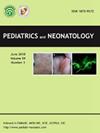Staphylococcus aureus pneumonia in neonates: clinical patterns, laboratory findings and outcomes
IF 2.1
4区 医学
Q2 PEDIATRICS
引用次数: 0
Abstract
Background
Staphylococcus aureus (SA) pneumonia is a leading cause of neonatal morbidity and mortality, particularly with methicillin-resistant Staphylococcus aureus (MRSA). Despite its prevalence, limited studies have focused on clinical presentation, antimicrobial resistance patterns, and outcomes of SA pneumonia in neonates. This study aimed to explore the clinical features, laboratory findings, and outcomes of neonates with SA pneumonia at the National Children's Hospital, Vietnam.
Methods
We conducted a retrospective observational study on 31 neonates diagnosed with SA pneumonia from January 2022 to June 2023. Clinical data, including demographic details, symptoms, white blood cell (WBC) count, C-reactive protein (CRP) levels, antimicrobial susceptibility, and radiological findings, were collected. We analyzed the antibiotic resistance patterns of SA and evaluated factors associated with vancomycin treatment failure.
Results
Of the 31 neonates, 96.8 % were diagnosed with MRSA pneumonia. The main clinical symptoms were fever (77.4 %), tachypnea (83.9 %), and chest retraction (80.6 %). SA was primarily isolated from endotracheal fluid (71.0 %), pleural fluid (41.9 %), and both combined (51.6 %) with positive blood cultures. Complications were common, with pleural effusion in 54.8 %, pneumothorax in 48.4 %, necrotizing pneumonia in 25.8 %, and lung abscess in 29.0 % of cases. Vancomycin was the primary antibiotic administered, though treatment failure occurred in 38.7 % of cases, necessitating alternative antibiotics, particularly in patients with severe illness requiring mechanical ventilation, vasopressor support, and elevated CRP levels (>15 mg/L). Most strains were resistant to beta-lactam antibiotics but sensitive to vancomycin, linezolid, ciprofloxacin, and levofloxacin. The average hospital stay was 24.4 ± 12.6 days, with a mortality rate of 12.9 %, mainly due to severe respiratory failure and septic shock.
Conclusion
These findings highlight the critical importance of early diagnosis, optimized antibiotic therapy, and careful monitoring to reduce complications and improve survival outcomes in neonates with SA pneumonia.
新生儿金黄色葡萄球菌肺炎:临床模式、实验室结果和结果
背景:金黄色葡萄球菌(SA)肺炎是新生儿发病率和死亡率的主要原因,尤其是耐甲氧西林金黄色葡萄球菌(MRSA)。尽管其流行,有限的研究集中在新生儿SA肺炎的临床表现、抗微生物药物耐药性模式和结局。本研究旨在探讨越南国立儿童医院新生儿SA肺炎的临床特征、实验室结果和结局。方法:对2022年1月至2023年6月诊断为SA肺炎的31例新生儿进行回顾性观察研究。收集临床资料,包括人口统计学细节、症状、白细胞(WBC)计数、c反应蛋白(CRP)水平、抗菌药物敏感性和放射学结果。我们分析了SA的抗生素耐药模式,并评估了万古霉素治疗失败的相关因素。结果:31例新生儿中,96.8%确诊为MRSA肺炎。主要临床症状为发热(77.4%)、呼吸急促(83.9%)、胸后缩(80.6%)。SA主要从气管内液(71.0%)、胸膜液(41.9%)和两者结合(51.6%)中分离,血培养阳性。并发症常见,胸腔积液54.8%,气胸48.4%,坏死性肺炎25.8%,肺脓肿29.0%。万古霉素是主要使用的抗生素,尽管38.7%的病例出现治疗失败,需要使用替代抗生素,特别是那些需要机械通气、血管加压素支持和CRP水平升高(> - 15 mg/L)的重症患者。大多数菌株对-内酰胺类抗生素耐药,但对万古霉素、利奈唑胺、环丙沙星和左氧氟沙星敏感。平均住院时间为24.4±12.6 d,死亡率为12.9%,主要以严重呼吸衰竭和感染性休克为主。结论:这些发现强调了早期诊断、优化抗生素治疗和仔细监测对于减少新生儿SA肺炎并发症和改善生存结果的重要性。
本文章由计算机程序翻译,如有差异,请以英文原文为准。
求助全文
约1分钟内获得全文
求助全文
来源期刊

Pediatrics and Neonatology
PEDIATRICS-
CiteScore
3.10
自引率
0.00%
发文量
170
审稿时长
48 days
期刊介绍:
Pediatrics and Neonatology is the official peer-reviewed publication of the Taiwan Pediatric Association and The Society of Neonatology ROC, and is indexed in EMBASE and SCOPUS. Articles on clinical and laboratory research in pediatrics and related fields are eligible for consideration.
 求助内容:
求助内容: 应助结果提醒方式:
应助结果提醒方式:


